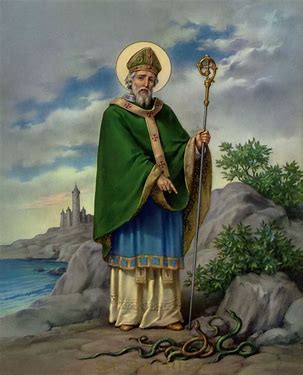
Image Source Catholic Pictures
Material sources distilled from: St. Patrick after the Ancient Irish Narrations interview with James Lynch and Pilgrims and Prophets (2015) by Fr. Edmond Cullinan of the Waterford and Lismore diocese.
St. Patrick was born in 385 A.D. and grew up among the Britons, in a British colony off the English channel called Armorica. Patrick’s father, was Calphurnius, a deacon. His mother was Conchessa, a close relative of Saint Martin of Tours in present day France. As a teenager Patrick was captured by the Irish King Nial who often would capture noble offspring, as a ransom for Irish national security. Nial had taken many hostages on the day he kidnapped Patrick from the colonial coastline. For example, Patrick’s two sisters Lupita and Derereca, were kidnapped. Nial brought the captives back to Ireland some distance away by sea. In St. Patrick’s ”Confessio” he mentioned the sailing distance between Ireland and his British homeland, saying ‘’We forthwith sailed, and, in a three days’ run, we took the land’’.
Now for his first time Patrick finds himself among the Irish. The boy Patrick was sold as a slave to Milcho, and he was to Shepard sheep in the Slemish mountains of Antrim in the northeast of Ireland. It was there he gave himself to a life of prayer, being so far from home at sixteen years of age. He turned to God, praying 100 times a day, and a 100 times a night as recounted in his ”Confessio”.
It was during Patrick’s spell as a slave, where he learned to speak ‘’as Gaeilge’’, as Milcho’s son, and two daughters would speak and befriend this curious looking foreigner. It was from them, Patrick learned the Irish customs, traditions and culture. His six years as a slave in Ireland prepared him somewhat for a future mission which God had in mind.
One night in a dream, he heard an angel called Victor, speak to him. The angel Victor gave Patrick advice, on how to free himself from slavery, and about a ship waiting for him a good distance away. Milcho would not let Patrick free without a ransom. So the angel Victor told Patrick to follow a certain boar who would uproot a lump of gold, large enough for the ransom. Patrick got the gold to give to his master, and was allowed to go. But Milcho soon regretted his decision, and in vain went searching for his former faithful slave boy. Patrick would find a waiting ship, that would set sail out of Ireland upon waiting a favourable wind. With some time and adventures, Patrick made it back to his homeland amongst the Britons whom lived there.
The second trip to Ireland would come much later, but in a dream Patrick could here the cry of the Irish to return and walk with them again. Patrick would prepare in advance for such a return. He underwent formation for priesthood, to help in his future Irish mission. He spent four years in Tours, where St. Martin received him like a son. The future patron saint of Ireland was tonsured at Tours by St. Martin. Reverend Patrick was to spend a further eight years with hermits at Lérins under St. Germanus of Auxerre. It was St. Germanus who sent Rev. Patrick to Rome. The angel Victor had also told Patrick to prepare his mission to Ireland. When he arrived in Rome, Rev. Patrick was honourably received by Pope Celestian, who despatched him to Ireland, with a mission team and relics of the saints. In Rome, the patron saint elect met St. Ciarán and St. Declan who went to Ireland on minor apostolic missions before him. Patrick on his return trip to Ireland as Bishop, headed to the Gaels with his team, via the English Channel and with his bishop’s staff, called the ”bachal Isu” the staff of Jesus. The Most Rev. Patrick was returning to Ireland with apostolic authority. The Bishop of Ireland and his prelates would sail by Wales, along the Irish Sea. As they sailed along the Welsh coast, he received the prophecy of St. David.
Now Patrick already knowing the customs of Ireland from his time as a slave, and he knew how to speak Irish well, so he had a great advantage. He arrived in Ireland with his apostolic mission team. Patrick knew where to go, and lit the paschal fire on the hill of Slane. This fire was seen at the royal Tara hill, and the Irish King Leary was angry and called his pagan advisors (the ‘’Draoi’’), what it meant? For the pagans, Patrick’s lit fire was a bad omen, as the paschal fire would overthrow their kingdom as a new kingdom of Christianity was to be ushered in.
Indeed Patrick’s fire set the country on fire with love for Jesus. In Patrick’s ”Confessio”, he tells us that the sons and daughters of the Irish were dedicating themselves as monks and virgins of Christ. St. Patrick promoted this enthusiastically. Later literature say that Patrick set up communities of nuns alongside churches he founded. On Croagh Patrick, tradition holds that he spent forty days and nights fasting and praying like Moses on Mount Sinai. Monks are known for their ascetic life.
The monastic system began with St. Anthony of Egypt (251-356). This system spread to the island of Lérins in the bay of Cannes in Province, in present day southern France where St. Honoratus (350-430) founded a monastery. St. Patrick spent time there under St. Germanus of Auxerre.
A good account of Patrick’s early mission history can be found accessible to us thanks to Fr. Patrick Peyton, an Irish priest who found the Family Theatre Production company in the United States in the 1950s. Peyton’s devotion to St. Patrick lead to the short film production called Trial at Tara which we can view here. Its about 20+ minutes long, and the acting is of good quality.